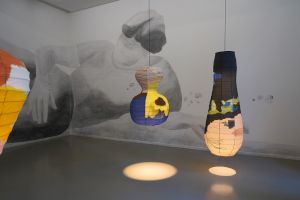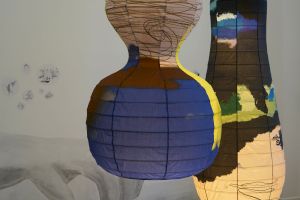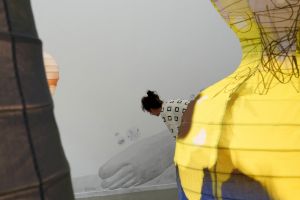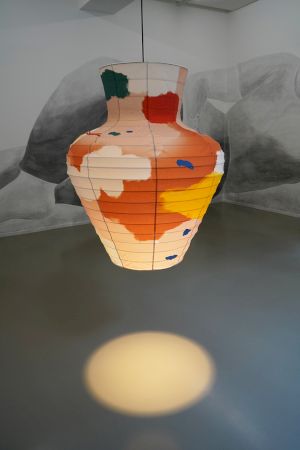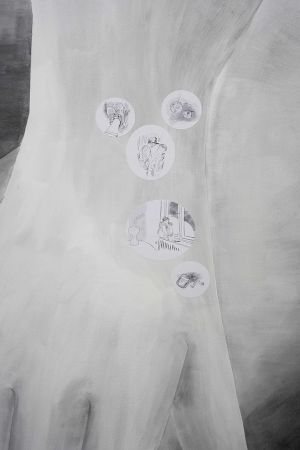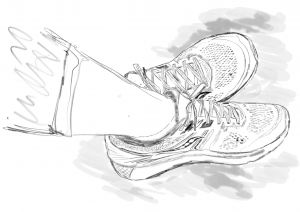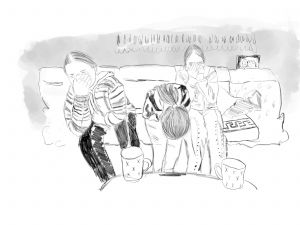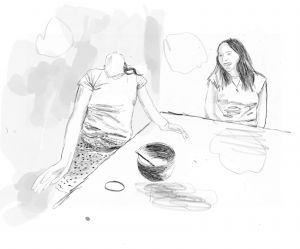Claudia & Julia Müller
Une brève histoire de baskets sales
MÉDIATION
Visite flèche : tous les week-ends, 16:00 (20’)
Curator tour jeudi 21 octobre à 17:00 (45’)
à l’occasion de Nuit Blanche le 3 octobre l’exposition sera exceptionnellement ouverte jusqu’à 00:00
↘ En parallèle exposition de Denise Bertschi, Oasis of Peace. Neutral Only On The Outside
Claudia & Julia Müller (*1964; *1965) stage familiar or mysterious situations in large-scale, partly hand-drawn murals, fusing figurative representation with ornaments and fragments, abstraction and dissection. Drawing on their vast archive of images, they examine looks exchanged, power structures, and the interrelation of affection and animosity; in short, the entire contradictory range of human existence. Using portraiture along with an installation of painted lamps that connects interior and exterior spaces, the exhibition at the CCS focuses on moments of transition, forms of living together, and situations of fragility and reorientation.
The Müller sisters take images from their archive and reproduce them in the form of large-scale, partly hand-drawn murals. This process allows them to highlight elements that may at first glance seem to veil or reveal human behaviors. Julia Müller defines their artistic practice as a means both of stepping back from human nature, the better to analyze it, and of accessing the obscurer recesses of their minds: “For me, it is […] a study of the strange areas and my projections and prejudices towards them. Redrawing is like rethinking your opinions; thus, the material is kept alive.”1
Their method of reactivating images through manual repetition is a way of “slowing down” the gaze in the present day, a time increasingly flooded by photographic images. Propelled by our desire to see, our pleasure in seeing (—“visual pleasure,” à la Laura Mulvey), as well as by our exhibitionist tendencies, images have gained unforeseeable importance, or omnipresence, even. This overexposure can also, paradoxically, obscure our capacity to see, or rather, to recognize whatever it is we see. To select or be arrested by a specific image, to analyze it by copying and translating the data—something digital, ephemeral, immaterial—into a more permanent form—the hand-drawn mural— therefore allows the artists as well as their public to appropriate a different way of seeing the image (differently). Their research insofar has much in common with Walter Benjamin’s concept of the “optical unconscious.”
However, the artists’ practice of gleaning and transforming images never sinks into nostalgic comparison or comments on the evolution of communications technology and image (re)production (which they themselves assiduously use). Their slightly off-kilter gaze zooms in rather, on habits and gestures, and it is this which enables them to differentiate certain aspects of contemporary life.
Adam Szymczyk, in conversation with Claudia & Julia Müller, once drew a parallel between their artistic practice and Giorgio Agamben’s definition of contemporaneity. 2 According to Agamben— whose work is grounded in Nietzsche’s concept of the untimely—any evocation of the past, any taste for the anachronistic, is a sign of the lucidity required to interpret the present. Seen from this angle, the present (and its somber aspects) can only ever be revealed by falling out of step with it.3 Une brève histoire de baskets sales (A Brief History of Dirty Sneakers) takes individual change as its point of departure, threshold moments of transformation and personal quests that arise when coming of age. The Müller sisters draw on their own experience, in addition to observation and research.
The installation at the Swiss Cultural Center consists in large textile objects printed with digital paintings. The walls are covered with sketches of a monumental bodyscape, inhabited by small figurative drawings in black and white. The Müller sisters often use (self) portraiture and thereby consider the backdrop to such likenesses, namely the particular ways people want to see and be seen, “Our interest and research [being] the problems of humans, and into how people represent themselves towards others.” 4
The walls speak of palimpsest and shadows. The Müller sisters tread a thin line between the image in the making and the finished product, equally welcoming moments of focus and blur. They also mix analog and digital ways of deleting images, from the rubber eraser to the Photoshop version. In these murals of the unseen, silhouettes and sharply contoured details are strikingly contrasted. Fragments surface like remarkable periods or unforgettable encounters, forever anchored in memory—yet subject nonetheless to the shifting tides and lights of the subconscious.
The exhibition venue and its inner courtyard are occupied by large print sculptures, organic forms that resemble human silhouettes and household lanterns, so melding interior and exterior space.
These two installations in juxtaposition—one outside, the other inside, one abstract, the other mimetic—are evidently in dialogue. In a sense, they reflect a process of twofold creation which thrives on disagreement, on the to and fro and back and forth of autonomous sisters/artists, which, while not necessarily ending in happy compromise, yet allows articulation of two possible paths (and voices).
— Claire Hoffmann
Translation Jill Denton
1 Adam Szymczyk in conversation with Claudia & Julia Müller „’Ah, speak for yourself!’ On the recent practice of Claudia & Julia Müller“, in: Claudia & Julia Müller, ed. Barbara Krimm, Claudia & Julia Müller, argobooks, Berlin, 2014, p. 117-122, ici p. 115.
2 Ibid., ici p. 121.
3 Giorgio Agamben, „What Is the Contemporary?“, in: What Is an Apparatus?, Stanford University Press, 2009.
4 Adam Szymczyk in conversation with Claudia & Julia Müller „’Ah, speak for yourself!’ On the recent practice of Claudia & Julia Müller“, in: Claudia & Julia Müller, ed. Barbara Krimm, Claudia & Julia Müller, argobooks, Berlin, 2014, p. 117-122, ici p. 113.
Press release
Texte des artistes
Partenaires
Partenaires média : Libération, Mouvement, Zéro Deux
Soutiens
Avec le généreux soutien de Dr. Georg und Josi Guggenheim-Stiftung et du département de la culture de Bâle-Ville.
bio
Claudia & Julia Müller (* 1964 and * 1965) live and work in Basel and Berlin. They studied at the Basel School of Art, Julia graduated in textile design and Claudia continued her studies in Germany. The sisters have been creating as a duo since 1991. They create multi-faceted works combining wall drawings, installations, videos and objects. In recent years, they have focused their reflections on contemporary social phenomena, exploring human relationships and revealing the contradictory facets that characterize them.
They have participated in numerous group exhibitions in Switzerland and abroad, including Taller 108 in Lima (2019), Kunstmuseum Basel (2017), Maccarone Inc. New York (2015), Kunsthaus Zurich (2015), Kunsthalle Nürnberg (2014), MoMA New York (2009), MOCA Miami (2008), and the De Appel Foundation in Amsterdam (2007).
The sister-artists also take on public spaces by winning competitions mixing art and architecture with, among others, the sculpture Geschwister Tanner in a school in Uster (Switzerland) in 2019, the ceramic carpet It’s this rug I have, it really tied the room together in a school in Basel (Switzerland) in 2016, and the ceramic wall Ficelle at the Residential House Birsfelden in Basel in 2013.
Claudia and Julia Muller have received several awards, including the Meret Oppenhein Prize (2010) and the Kantonalbank Kunstpreis Baselland (2010) for their work together. They have been residents at MoMA PS1 in New York (1999).
In parallel to their artistic practice, Claudia Müller has been a professor at the HEAD in Geneva since 2007 and Julia Müller has been teaching at the Kunstakademie in Karlsruhe (Germany) since 2005. They have taught and lectured at numerous private and public schools and institutions such as PS1 (New York), Piet Zwart Institute (Rotterdam), Kunstmuseum (Bern), Hochschule für Bildende Künste (Braunschweig).
Their work is represented by the galleries Peter Kilchmann (Zurich), Mehdi Chouakri (Berlin), Karin Günther (Hamburg) and Maccarone (New York).

